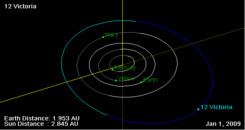Discovered by John Russell Hind Pronunciation /vɪkˈtɔəriə/ Minor planet category Main belt Discovered 13 September 1850 Spectral type S-type asteroid | Discovery date 13 September 1850 Alternative names none Orbital period 1,302 days Orbits Sun Discoverer John Russell Hind | |
 | ||
Named after Victoria (Latin: Uictōria) Discovery site George Bishop's Observatory, George Bishop's Observatory, Regent's Park Similar John Russell Hind discoveries, Other celestial objects | ||
12 Victoria is a large main-belt asteroid.
It was discovered by J. R. Hind on September 13, 1850.
Victoria is officially named after the Roman goddess of victory, but the name also honours Queen Victoria. The goddess Victoria (Nike for the Greeks) was the daughter of Styx by the Titan Pallas. The coincidence with the name of the then-reigning queen caused quite a controversy at the time, and B. A. Gould, editor of the prestigious Astronomical Journal, adopted the alternate name Clio (now used by 84 Klio), proposed by the discoverer. However, W. C. Bond, of the Harvard College Observatory, then the highest authority on astronomy in America, held that the mythological condition was fulfilled and the name therefore acceptable, and his opinion eventually prevailed.
Radar and speckle interferometry observations show that the shape of Victoria is elongated, and it is suspected to be a binary asteroid, with a moon of irregular shape.
Victoria has only ever been observed to occult a star thrice since its discovery.
